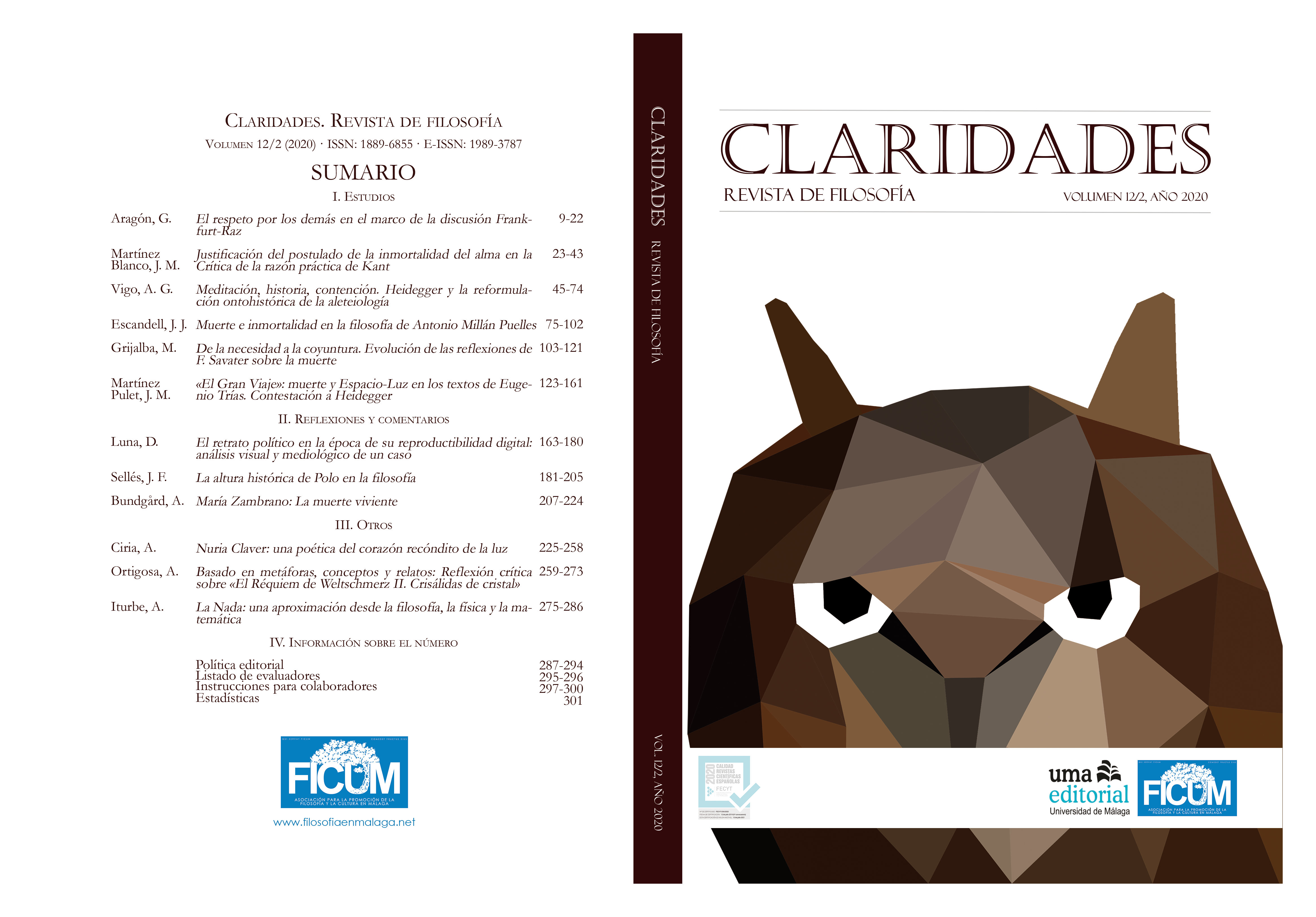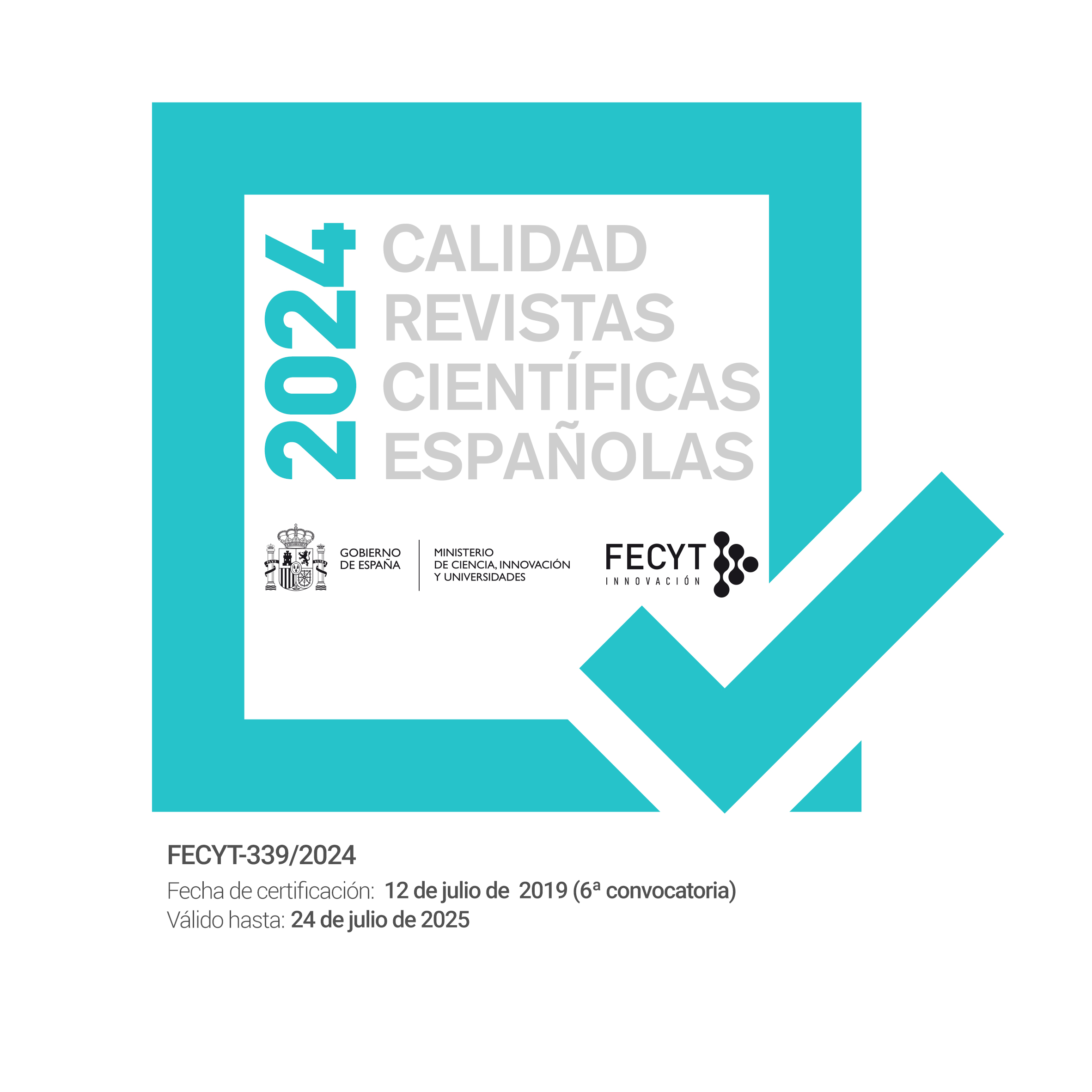María Zambrano: La muerte viviente
DOI:
https://doi.org/10.24310/Claridadescrf.v12i2.7586Keywords:
Life-Giving Death, Awakening, original Feeling, Genuine Life, BeingAbstract
María Zambrano did not think of death as end of life, but rather as «genuine life». She understood it as instants of radical loss that the subject lives through in a limit-experience which she herself characterized as one of being cast away or «shipwrecked». The article addresses the dialectical relation between life and death
seen as complementary poles in María Zambrano’s metaphysics. There is no life without death, she says, for being emerges from nothingness. When it feels being, the subject initiates a dying which is an «awakening» of the creative love it received in the origin of life. Death is a source of hope and wisdom for whom accepts its
presence.
Downloads
Metrics
Publication Facts
Reviewer profiles N/A
Author statements
Indexed in
-
—
- Academic society
- N/A
- Publisher
- Asociación para la promoción de la filosofía y la cultura en Málaga (FICUM) y UMAEditorial
References
Baudrillard, Jean, (1980). El intercambio simbólico y la muerte, Monte Avila Editores, Barcelona, pp.143-156.
Bloom, H. (2005). ¿Dónde se encuentra la sabiduría?, Madrid: Taurus. Bundgård, A. (2000). Más allá de la filosofía. Sobre el pensamiento filosófico-místico de María Zambrano, Madrid: Trotta.
Bundgård, A. (2007): «Exilio y Transcendencia», en Aurora. Papeles del Seminario María Zambrano, 8, pp. 83-89.
Buber, M. (2008). Ich und Du, Stuttgart: Reclam.
Colinas, A. (2019). Sobre María Zambrano. Misterios encendidos, Madrid: Siruela.
Ferrater Mora, J. (1962). El ser y la muerte, Madrid: Aguilar.
Ferrater Mora, J. (1991). Diccionario de Filosofía, 3, K-P, Barcelona:Círculo de Lectores.
Gil Guinea, L. (2019). La «filosofía del umbral». Aldo van Eyck en el Hohar para niños en Amsterdam.1954-59, en Revista Europea de Investigación en Arquitectura, 13.
Gil Guinea, L. (2016). Lugares intermedios: «la filosofía del umbral» en la arquitectura del Team10.Tesis (Doctoral), https://doi.org/10.20868/UPM. thesis.43751.
Zambrano, M. (1986). El hombre y lo divino, México: Fondo de Cultura Económica.
Zambrano, M. (1986). La tumba de Antígona, Senderos, Barcelona: Anthropos.
Zambrano, M. (1987). Hacia un saber sobre el alma, Madird: Alianza.
Zambrano, M. (1987). «A modo de autobiografía», en Revista Antrophos, 70/71, pp.69-73
Zambrano, M. (1987). El pensamiento vivo de Séneca, Madrid: Cátedra.
Zambrano, M. (1988). Claros del bosque, Barcelona: Seix Barral.
Zambrano, M. (1989). Notas de un método, Madrid: Mondadori.
Zambrano, M. (1989). Delirio y destino, Barcelona: Círculo de Lectores.
Zambrano, M. (1994). España, sueño, verdad, Madrid: Siruela.
Zambrano, M. (1995). «Un descenso a los infiernos», Cuadernos de Estética FULGORES, 3.
Downloads
Published
How to Cite
Issue
Section
License
Esta revista provee acceso libre inmediato a su contenido bajo el principio de hacer disponible gratuitamente la investigación al público. Todos los contenidos publicados en Claridades. Revista de Filosofía, están sujetos a la licencia Creative Commons Reconocimento-NoComercia-Compartirigual 4.0 cuyo texto completo puede consultar en <http://creativecommons.org/licenses/by-nc-sa/4.0>
Es responsabilidad de los autores/as obtener los permisos necesarios de las imágenes que están sujetas a derechos de autor.
Los autores/as cuyas contribuciones sean aceptadas para su publicación en esta revista conservarán el derecho no exclusivo de utilizar sus
contribuciones con fines académicos, de investigación y educativos, incluyendo el auto-archivo o depósito en repositorios de acceso abierto de cualquier tipo.
La edición electrónica de esta revista esta editada por la Editorial de la Universidad de Málaga (UmaEditorial), siendo necesario citar la procedencia en cualquier reproducción parcial o total.

















6.png)
